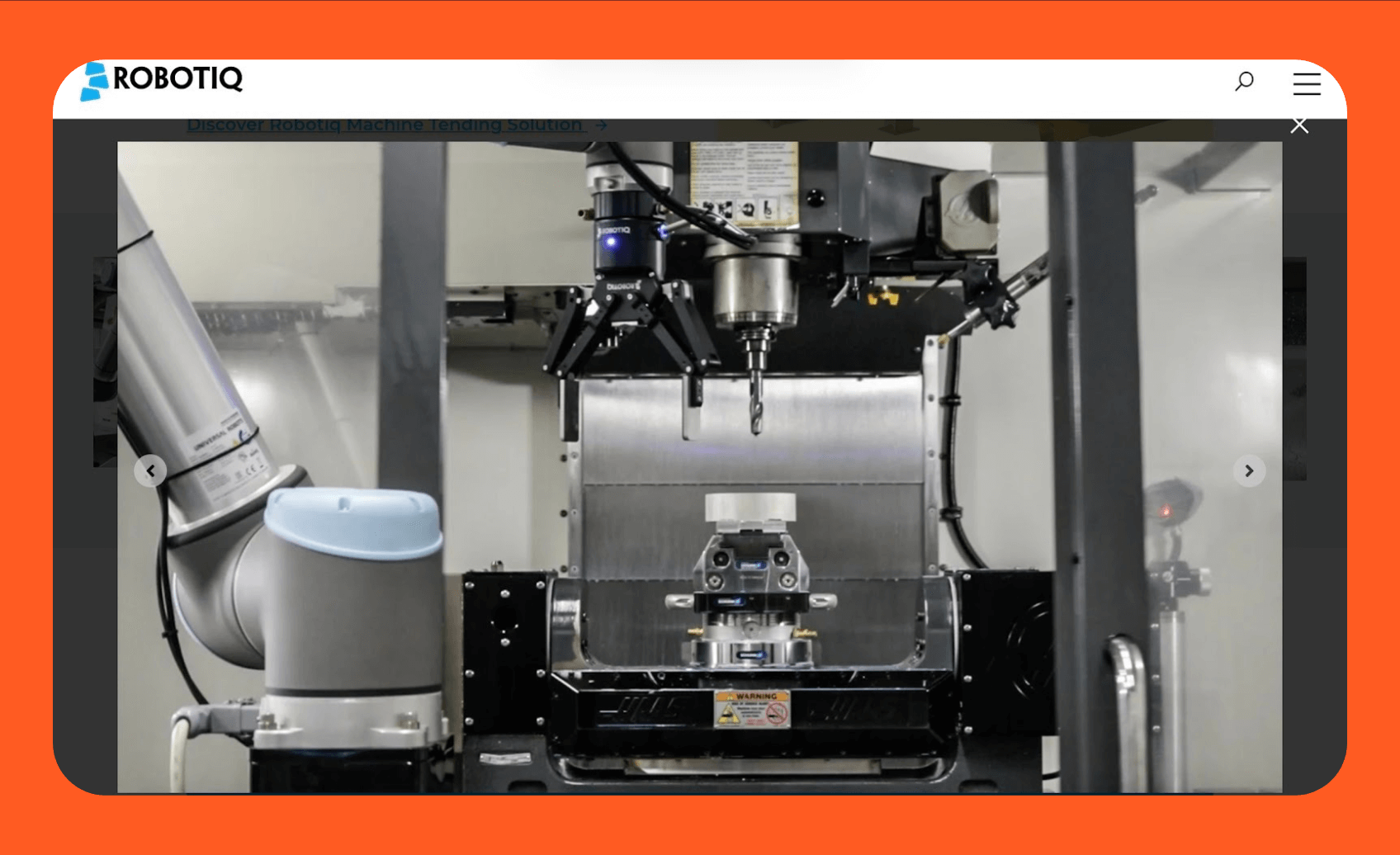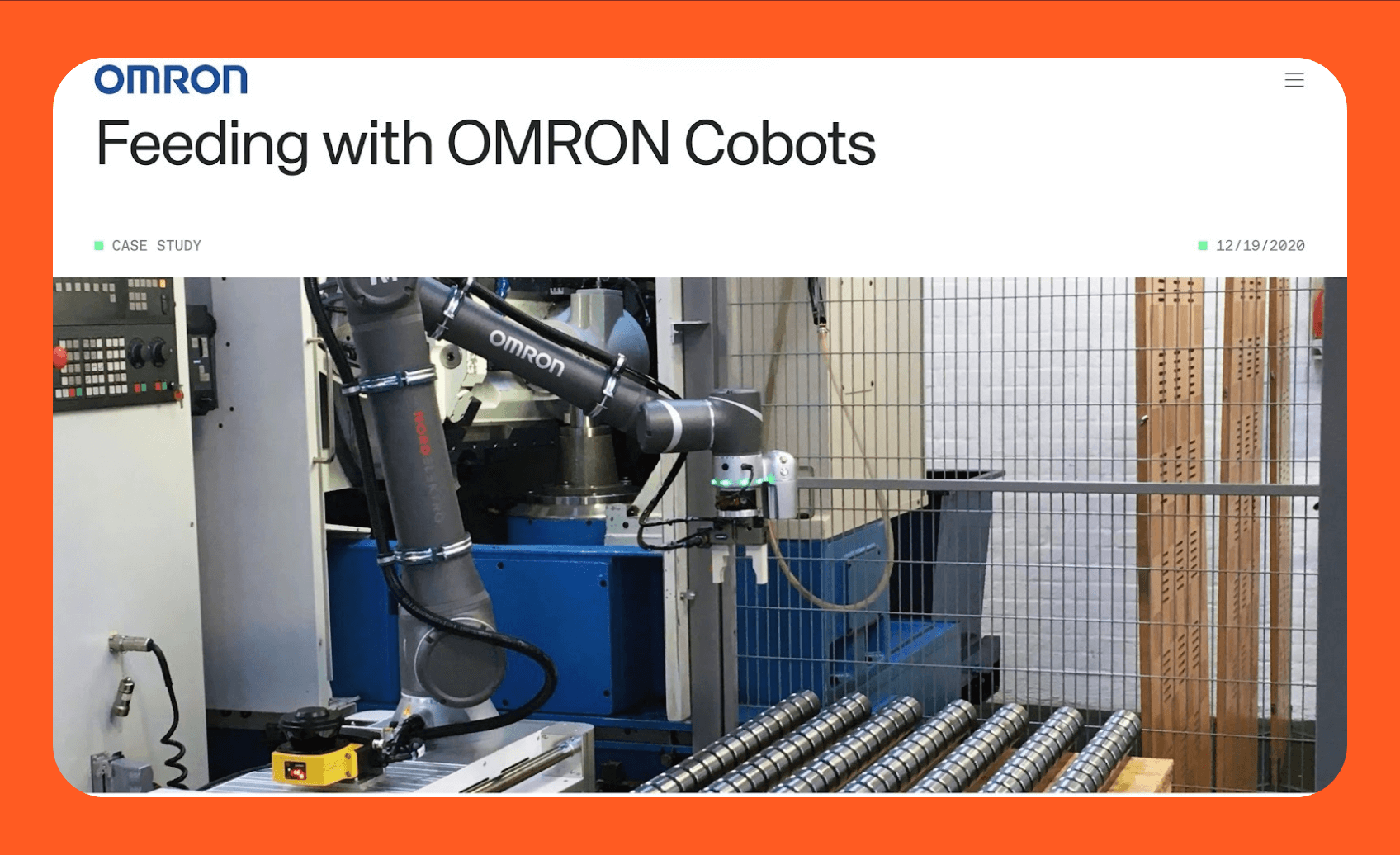Manual loading limits how long CNC machines stay productive. CNC machine tending automates pick, place, and cycle start tasks using robots, sensors, and connected software to keep spindles running longer.
What is CNC machine tending?
CNC machine tending is the automated process of loading and unloading raw materials and finished parts from a Computer Numerical Control (CNC) machine, typically using a robot. The robot performs these steps with high repeatability, reducing downtime between operations and keeping the machine spindle cutting for longer periods.
Most CNC setups are ideal for tending because they already operate on repeatable programs and use standard I/O or Ethernet ports that connect easily to a robot controller. Once integrated, the system can communicate in both directions, telling the robot when the machine door is open, a part is ready, or the robot loads the next blank.
The result is a closed-loop workflow where the robot and CNC act as a single, synchronized unit. It is the foundation of what manufacturers often call lights-out CNC operation, where machines run continuously with minimal human intervention, even overnight.
Notably, unplanned downtime drains 11% of annual revenue for major companies, with automotive losses reaching $2.3 million per hour. By automating routine work, CNC tending boosts uptime and lets operators focus on programming and quality.
How CNC machine tending works
CNC machine tending works by automating every step of the loading and unloading process through a robotic cycle that repeats with precision and timing. The system keeps machines running continuously by managing part transfers, signals, and tool coordination between the robot and the CNC.
Here’s how a typical tending cycle operates:
- Picking the part: The robot arm lifts raw material from a feeder or tray using a gripper or vacuum tool.
- Loading the machine: It places the part into the CNC chuck or fixture with exact alignment.
- Starting the cycle: Once the door closes and safety checks are complete, the robot triggers the CNC to begin machining.
- Monitoring progress: Sensors confirm when the machining cycle finishes before the robot re-enters the workspace.
- Unloading the part: The robot removes the finished piece and places it on an output tray or conveyor.
- Repeating automatically: The loop continues for each part, maintaining production without breaks.
Each cell combines a robotic arm, end-of-arm-tooling, sensors, vision guidance, and Ethernet or I/O communication. Integrated setups connect directly to the machine controller for smooth operation, while standalone units offer flexibility to move between different CNC stations.
CNC tending vs. manual operation
CNC tending vs. manual operation compares performance, accuracy, labor use, cost, and safety across both approaches.
Benefits of CNC machine tending
The benefits of CNC machine tending include productivity, cost efficiency, precision, and safety.
- Consistent precision: Each cycle runs at the same speed and angle for consistent placement.
- Safer working environment: Automation removes workers from repetitive lifting, coolant exposure, and sharp tools, minimizing fatigue and injury risks.
- Easy scalability: Once a cell is proven efficient, you can copy the same setup to other CNCs to scale capacity quickly.
- Continuous operation: Robots allow CNC machines to run beyond human shifts, maintaining production even overnight or during weekends.
- Lower labor costs: Automated tending reduces manual involvement, so a single operator can supervise multiple machines.
- Heavy-duty capacity: For 30 kg payloads, robots like Standard Bots Thor handle large part manipulation.
Challenges and limitations
The challenges and limitations of CNC machine tending mainly involve setup costs, technical integration, and handling complexity.
- Maintenance and calibration: Regular cleaning, recalibration, and software updates are essential for industrial robot maintenance and preventing unplanned downtime.
- Changeover time: Switching between part types or programs can slow production if fixtures and setups are not standardized in advance.
- Initial investment and setup time: Installing a tending cell requires investment in hardware, integration, and safety systems. The upfront cost can be high for smaller shops, but the payoff grows steadily through higher productivity.
- Integration complexity: Robots must communicate easily with the CNC machine through Ethernet or I/O connections. Older machines may lack this compatibility, requiring additional interfaces or retrofitting.
- Part variability: Robots perform best with uniform parts. Irregular shapes or delicate materials may require advanced grippers, adaptive vision, or manual assistance, which can add cost and complexity.
While industrial automation brings strong long-term gains, the initial phase demands careful planning, training, and system compatibility checks.
ROI and payback
The ROI and payback period for CNC machine tending depend on factors like production volume, labor rates, and machine uptime. When calculated correctly, the savings from reduced labor and downtime often recover the investment within a short timeframe.
Below are the main elements that determine return on investment:
- Labor savings: A single robot can replace or assist multiple operators, saving thousands of labor hours annually. These savings quickly offset initial equipment and integration costs.
- Increased uptime: Continuous operation extends productive hours per day. Even a 20% gain in spindle utilization can translate into significant yearly output increases.
- Reduced scrap and rework: Consistent part handling and precise positioning reduce errors and material waste, improving yield and profit margins.
- Lower operational costs: Robots reduce idle time, unplanned stoppages, and tool wear by maintaining predictable loading cycles.
- Typical payback period: Most machine tending systems achieve full payback within 12 to 24 months, depending on run time, part value, and labor rates.
For example, a medium-sized shop operating three CNC machines could save up to $70,000 a year in labor and downtime. Over two years, those savings typically exceed the cost of installing a compact robotic tending cell.
Best practices for CNC tending
The best practices for CNC tending focus on consistent setups, safe operations, and operator readiness to ensure smooth automation across machines.
- Standardize fixtures and orientations: Keep part placement consistent across machines to simplify programming and reduce errors during changeovers.
- Manage chips and coolant effectively: Maintain clean work zones and clear chip flow to prevent buildup that can interfere with robot grippers or sensors.
- Include proper guarding and sensors: Safety barriers, light curtains, and presence sensors protect workers and equipment during live operations.
- Train operators on programming basics: Even a short training session helps staff adjust programs or troubleshoot without relying on external support.
- Start small and scale: Begin with one pilot cell to refine cycle times and prove ROI, then extend automation to additional machines once results are consistent.
Following these principles ensures smoother integration, fewer interruptions, and longer equipment life.
Common use cases
Common use cases of CNC machine tending show how automation improves productivity across different machining operations and industries. Robots now manage repetitive loading and unloading in milling, turning, grinding, and EDM, allowing shops to keep machines running without interruption.
CNC milling

Milling needs constant part swaps and tool changes, making it perfect for robot tending. A robot loads raw billets, starts the cycle, and removes finished pieces with consistent alignment.
For example, Swivellink automated two FANUC Robodrill machines using a FANUC LR Mate robot and achieved a 33% increase in efficiency with a 33-week ROI. Such automation helps maintain uniform part quality while keeping machines active around the clock.
CNC turning

Turning operations depend on consistent chucking and orientation. Robots perform this with precision, avoiding part slippage and improving surface finish.
Walt Machine, a U.S. shop, used a UR10e cobot with a Robotiq gripper to tend its CNC lathes and doubled daily production on a single machine. After scaling the system, overall throughput grew by more than 2,500%, proving how much idle time automation can eliminate.
CNC grinding
Grinding tasks require precise and repeatable pressure. Robots maintain this balance better than manual operators, improving finish quality while reducing tool wear. Automated tending also protects workers from exposure to abrasive dust and repetitive motion fatigue, especially in high-volume finishing lines.
EDM and wire cutting
Electrical discharge machining and wire cutting demand delicate handling. Robots ensure accurate placement of fragile parts, reducing scrap and improving repeatability. Manufacturers in aerospace and toolmaking now rely on these systems to maintain micron-level tolerances during long production cycles.
Industry applications

Across sectors, CNC tending delivers measurable returns. Fischer Gears in Denmark automated 70% of its CNC loading with OMRON TM12 cobots equipped with vision sensors. The system distinguished raw and finished parts automatically, freeing workers from repetitive loading tasks.
In other examples, companies like WST Fab have reprogrammed and redeployed UR10e cobots across new CNC lines within days, showing how flexible, redeployable automation can scale with production needs.
Standard Bots CNC tending use case
Standard Bots offers a complete CNC machine tending package that includes the Standard Bots Core cobot, control box, modular workbench, pneumatic system, and gripper options for single or dual-part handling.
This configuration allows shops to automate loading, unloading, and button-pushing tasks without modifying the CNC machine. Optional add-ons, such as automatic door openers, safety scanners, and air-blow systems, make it adaptable for a wide range of part types and layouts.

By combining modular hardware with StandardOS no-code control, the Core setup can be deployed quickly and scaled across multiple CNCs to improve spindle uptime and reduce manual labor.
Choosing the right CNC tending system
Choosing the right CNC tending system depends on part size, production goals, safety needs, and available expertise. The right combination of robot, gripper, sensors, and software determines how efficiently your automation will perform on the shop floor.
- Payload and reach: Match the robot’s payload to your heaviest part, including the gripper weight. Ensure its reach comfortably covers the distance between the infeed, chuck, and unloading area.
- Repeatability and precision: For tight-tolerance work, look for robots offering repeatability of ±0.025 mm or better, such as the Standard Bots Core.
- Speed and safety balance: Cobots work best in shared spaces with lower speeds and built-in safety sensors. Industrial arms suit high-speed, high-volume operations that require guarding or fencing.
- End-of-arm tooling: Choose grippers suited to your material and geometry, including mechanical fingers, vacuum cups, or custom multi-zone tools for irregular shapes.
- Vision and sensors: Integrate 2D or 3D vision to detect part orientation and confirm placement. Proximity and door sensors prevent collisions and misloads.
- Connectivity with CNC: Confirm that your machine supports Ethernet or I/O communication. For older CNCs, consider retrofit kits or external interfaces to synchronize robot commands.
- Ease of programming: Look for systems with intuitive interfaces or no-code teaching. This shortens deployment time and allows operators to make quick changes without external help.
- Safety and layout: Map the cell for safe human access, clear material flow, and predictable robot motion. Include interlocks or light curtains where workers may enter active zones.
- Turnkey vs in-house integration: Turnkey systems reduce deployment time but cost more upfront. In-house setups offer flexibility but require programming and controls expertise.
- Scalability: Start with one pilot cell, then standardize trays, fixtures, and orientations to scale across additional CNCs with minimal reconfiguration.
Selecting the right system means balancing capability with simplicity. Full-stack vendors like Standard Bots, which design both hardware and control software in-house, make integration faster and more reliable across multiple machines.
Summing up
CNC machine tending turns one of the most repetitive shop-floor tasks into a predictable, high-value process. By automating part loading and unloading, manufacturers keep spindles running longer, improve quality, and reduce the strain on skilled operators.
While setup and integration take planning, the long-term payoff comes through higher machine utilization, lower labor costs, and safer working conditions.
As automation becomes more accessible, even small and mid-sized shops are achieving results once limited to large manufacturers. With full-stack solutions like those from Standard Bots, deploying robotic CNC tending has never been simpler or faster.
Next steps with Standard Bots’ robotic solutions
Looking to upgrade your automation game? Standard Bots Thor is built for big jobs, while Core is the perfect six-axis cobot addition to any automation setup, delivering unbeatable precision and flexibility.
- Affordable and adaptable: Core costs $37k. Thor lists at $49.5k. Get high-precision automation at half the cost of comparable robots.
- Perfected precision: With a repeatability of ±0.025 mm, both Core and Thor handle even the most delicate tasks.
- Real collaborative power: Core’s 18 kg payload conquers demanding palletizing jobs, and Thor’s 30 kg payload crushes heavy-duty operations.
- AI-driven simplicity: Equipped with advanced demonstration learning and real-time adaptation through Standard Bots’ vertically integrated AI platform, Core and Thor integrate smoothly with CNC operations for flexible automation.
- Safety-first design: Machine vision and collision detection mean Core and Thor work safely alongside human operators.
Schedule your on-site demo with our engineers today and see how Standard Bots Core and Thor can bring AI-powered greatness to your shop floor.
FAQs
1. What is CNC machine tending used for?
CNC machine tending automates repetitive loading and unloading tasks on CNC machines. It keeps production continuous, improves precision, and frees operators from manual handling so they can focus on higher-value work like programming and inspection.
2. Can robots work safely around operators?
Robots can work safely around operators when the cell meets ISO 10218 and ISO/TS 15066 requirements and passes a risk assessment. Cobots like the Standard Bots Core follow ISO and TS 15066 safety standards, allowing them to operate beside humans without risk of collisions or injuries.
3. How long does installation take?
Installation for the CNC machine tending typically takes 1 day to 1 week. It depends on application complexity. Preconfigured solutions can be deployed in a few days.
4. Which machines work best with CNC tending?
Machines that work best with CNC tending are those with Ethernet or I/O compatibility, automatic doors, and standardized fixtures. These features make integration faster and help the robot communicate effectively with the CNC controller.
5. What is the typical ROI for CNC automation?
The typical ROI for CNC automation falls between 12 and 24 months. Most manufacturers see savings from reduced labor costs, improved uptime, and consistent precision that lowers scrap and rework.
brighter future
Join thousands of creators
receiving our weekly articles.







%2520(1).png)
.png)

